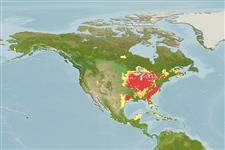Classification / Names
Common names | Synonyms | Catalog of Fishes (gen., sp.) | ITIS | CoL | WoRMS | Cloffa
Actinopterygii (ray-finned fishes) >
Lepisosteiformes (Gars) >
Lepisosteidae (Gars)
Etymology: Lepisosteus: Greek, lepis = scale + Greek, osteon = bone; bony sacled (Ref. 45335); osseus: From the word osseus, meaning bony (Ref. 10294).
Environment / Climate / Range
Ecology
Freshwater; brackish; demersal; pH range: 7.0 - 25.0; dH range: 10 - 15; depth range 0 - ? m (Ref. 55225), usually 0 - ? m (Ref. 55225). Temperate; 12°C - 20°C (Ref. 2060), preferred ?; 47°N - 24°N, 97°W - 69°W (Ref. 55225)
North and Central America: along the coasts and inland from Quebec to northern Mexico.
Length at first maturity / Size / Weight / Age
Maturity: Lm 66.9 range ? - 80 cm
Max length : 200 cm TL male/unsexed; (Ref. 40637); common length : 17.5 cm TL male/unsexed; (Ref. 12193); max. published weight: 22.8 kg (Ref. 4699); max. reported age: 36 years (Ref. 12193)
Dorsal
spines
(total): 0;
Dorsal
soft rays
(total): 6-9;
Anal
spines: 0;
Anal
soft rays: 8 - 10. Long narrow snout. Olivaceous brown above and white below. Dark spots on median fins and on body (Ref. 37032). Scales ganoid: thin bony scutes on leading edges of unpaired fins, and on both edges of caudal fin (Ref. 4639).
Adults occur in sluggish pools, backwaters and oxbows of medium to large rivers, and lakes (Ref. 10294). Usually found near vegetation. Occasionally found in brackish waters. Spawning occur in freshwater and possibly slightly brackish water (Ref. 4639). Migrate up rivers during the spawning season (Ref. 4639). Eggs and larvae are demersal and adhesive (Ref. 4639). Voracious predator, feeding on various fishes and crustaceans. The roe is poisonous.
Robins, C.R., R.M. Bailey, C.E. Bond, J.R. Brooker, E.A. Lachner, R.N. Lea and W.B. Scott, 1991. Common and scientific names of fishes from the United States and Canada. Am. Fish. Soc. Spec. Pub. (20):183 p. (Ref. 3814)
IUCN Red List Status (Ref. 115185)
CITES (Ref. 94142)
Not Evaluated
Human uses
Fisheries: minor commercial; gamefish: yes; aquarium: public aquariums
More information
ReferencesAquacultureAquaculture profileStrainsGeneticsAllele frequenciesHeritabilityDiseasesProcessingMass conversion
Tools
Special reports
Download XML
Internet sources
